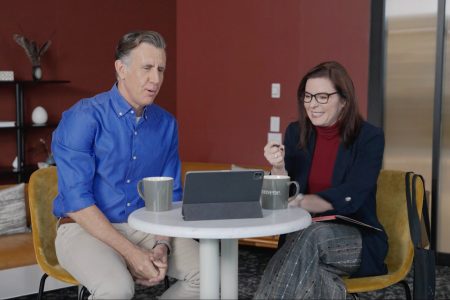If we are ever to hope for a workable solution to intergenerational tension in the workplace, it is incumbent on leaders and managers to first get our analysis right. The reality is that younger generations can be better at reading certain markets since they tend to constitute a large part of it, but older generations are more likely to spot a fad over secular change or societal pivot. Synthesize these points of view, and you have a perspective keyed into areas of potential growth buffered by realism and sustainability. What could go wrong?
The workplace can be a microcosm of society, and on-the-job tensions are nothing new. However, in an age where we are defining more differences between people than ever before, we risk overstepping those boundaries. Politics has also permeated America to such an extent that people are being led to believe that there are only two kinds of thinking: Blue or red. Healthy arguments have given way to a lot of noise.
None of this is fertile ground for peace at work, let alone peace in our time. But there is a way to bridge the generation gap between digital natives and their older colleagues. If we understand each other and the crises that have shaped every cohort, each generation’s beliefs and attitudes become more relatable and less adversarial. We would have common ground to build upon.
Related: How to Keep Workplace Relationships Drama-Free: Advice From Family-Run Franchises
Identifying intergenerational tensions
Mismatched expectations create different views on what is appropriate, what is inappropriate, and the value and meaning of work itself. Conflict between generations then tends to crystalize around interpersonal interactions and results in lazy stereotypes. So many expectations that drive intergenerational tensions — such as ambition, work-life balance, and socioeconomic structure — are subjective, so it can be hard to address the root cause.
It helps to understand that employee attitudes are molded early in their careers, so each new generation receives an abundance of information on how to operate in the workplace, but how they receive it is informed by the challenges unique to each era. For context, Boomers arrived in the workforce with a certain degree of stability that is foreign to Millennial workers, who have known nothing but change. Meanwhile, Gen Z entered the workforce in the midst of the pandemic, which presented unprecedented circumstances for all employees.
This disparity is apparent when processes are updated in the workplace. Each generation has had different conditioning in response to change, so divergent attitudes can cause disagreement and misunderstanding. But brokering peace requires that we go even deeper into the changes that created a whole new set of expectations for the different age demographics.
Related: 4 Ways To Overcome Age-Related Tension In The Office
Getting to the root cause
Every generation that has entered the workforce has faced at least one major crisis that shaped their values and affected the way they work and live. It’s a sobering thought, but the newest generation may not have even met their crisis yet. The pandemic drastically shifted the face of work, and for those new to the workforce, the post-COVID world bears little resemblance to the relative predictability enjoyed by those born between 1946 and 1964.
Boomers themselves were shaped by existential uncertainties, like the Cold War, the Vietnam War, or the civil rights movement. For newer generations, the growth of remote work accelerated by pandemic restrictions has denied them the opportunity to assimilate workplace norms by coming into the office. In one striking case reported by The New York Times, a young worker resorted to “stalking” Glassdoor reviews of her own company to learn about its culture.
It makes sense that being met with remote interactions in a fast-paced, ever-changing environment in the early stages of one’s career would significantly affect a young worker’s career mobility and attitude towards their employer. It also makes sense that older generations equate experience with authority. Getting to the bottom of each generation’s core beliefs offers the foundation for how to work with these differences.
Related: 3 Ways Technology Influences Generational Divides At Work
How to forge the path to peace
The problem with workplaces is that they are not always meritocracies. There are politics, shifting priorities, and the natural churn of talent or mobility. All of that can result in intergenerational tensions being put low on the priority list. Depending on the industry, management, and even ownership structure, companies risk losing the necessary diversity of opinions and approaches if they are not addressed.
In an ideal world, we would always have a harmonious, peaceful, and efficient environment, but the existence of tensions themselves is not inherently negative. In creative industries, we are familiar with competing ideas begetting innovation, yet competing viewpoints and even worldviews have the potential to create greater empathy and understanding if harnessed correctly.
When an employee is having issues, understanding what their “crisis” may have been can provide insight into the kind of coaching and assistance they may need or how to help adjust to the workplace dynamics they may have missed. Management can also provide opportunities for the generations to get to know each other in a collaborative environment. It shouldn’t be such a stretch to cultivate mutual respect because no one has been left untouched by the changes to the face of work.
Related: ‘They Think They’re Better Than You’: 74% of Managers Surveyed Say Gen Z Is More Difficult to Work With Than Other Generations
From binary to complementary: Working together
As managers and leaders, we must bring all people under our care into greater harmony — for everybody’s sake and for the business. If we are open-minded, objective, and willing to disarm tensions rooted in generational camps, we stand to gain from age-diverse teams. When members of intergenerational teams are encouraged to share and learn from their differences, decision-making, collaboration, and performance all improve.
With fewer younger workers entering the workforce due to changing demographics and the spate of early retirements during the pandemic, ensuring that the skill sets of each generation are treated as complementary is vital to maintaining operational efficiency. The solution to intergenerational tensions is getting our diagnosis right at the outset so we can work towards facing the next inevitable change or crisis together.
Read the full article here










